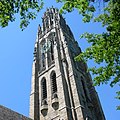Career
Academic research
McInnis is a scholar in the cultural history of American Art in the colonial and antebellum South. [3] Her work has focused on the relationship between art and politics in early America, especially on the politics of slavery. Her first book, "The Politics of Taste in Antebellum Charleston," was awarded the Spiro Kostof Award by the Society of Architectural Historians. [9]
Her 2011 book, "Slaves Waiting for Sale: Abolitionist Art and the American Slave Trade" was awarded the Charles C. Eldredge Book Prize from the Smithsonian American Art Museum [10] as well as the Library of Virginia Literary Award for nonfiction. In 2019 University of Virginia Press published her co-edited volume, "Educated in Tyranny: Slavery at Thomas Jefferson's University." She has also served as a curator, [11] consultant, and advisor to multiple art museums and historic sites.
Provostship
McInnis served as vice provost for academic affairs at the University of Virginia. Over her almost 20 years' experience at UVA, McInnis held various academic leadership and administrative appointments, including vice provost for academic affairs, associate dean for undergraduate education programs in the College of Arts and Sciences, director of American Studies, and as a professor of art history. She joined the faculty of UVA in 1998, earned tenure in 2005 and became a full professor in 2011. [4]
McInnis served as the provost of the University of Texas at Austin from 2016 to 2020. [12]
Stony Brook University
On March 26, 2020, McInnis was announced as the sixth president of Stony Brook University. [12] She began serving in this role on July 1, 2020. [13] McInnis won several political battles in support of Stony Brook University, including securing a $500 million donation from Jim Simons' Simons Foundation (the second-largest gift to a public university in American history), and a $700 million bid to lead the New York Climate Exchange campus on Governors Island. [14]
On May 13, 2024, the Stony Brook University Faculty Senate defeated a motion to censure McInnis, by a count of 55–51, over her role with regards to the arrest of 29 pro-Palestinian campus protestors and removal of a pro-Palestinian encampment earlier that month. [15] [16]
Yale University
In April 2024, the Yale Daily News reported that McInnis, who was appointed to Yale's Board of Trustees in 2022, was a candidate for the presidency of Yale University. [17] On May 29, 2024, McInnis was announced as the 24th president of Yale University. McInnis was formally installed on April 6, 2025, [18] becoming the first woman to serve as a non-interim president at Yale. [2]
This page is based on this
Wikipedia article Text is available under the
CC BY-SA 4.0 license; additional terms may apply.
Images, videos and audio are available under their respective licenses.

